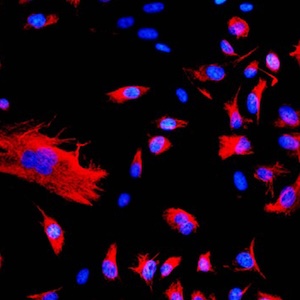SNORA38B promotes proliferation, migration, invasion and epithelial-mesenchymal transition of gallbladder cancer cells via activating TGF-β/Smad2/3 signaling

Submitted: 25 October 2023
Accepted: 4 December 2023
Published: 28 December 2023
Accepted: 4 December 2023
Abstract Views: 468
PDF: 148
HTML: 3
HTML: 3
Publisher's note
All claims expressed in this article are solely those of the authors and do not necessarily represent those of their affiliated organizations, or those of the publisher, the editors and the reviewers. Any product that may be evaluated in this article or claim that may be made by its manufacturer is not guaranteed or endorsed by the publisher.
All claims expressed in this article are solely those of the authors and do not necessarily represent those of their affiliated organizations, or those of the publisher, the editors and the reviewers. Any product that may be evaluated in this article or claim that may be made by its manufacturer is not guaranteed or endorsed by the publisher.
Similar Articles
- M. Úbeda-Manzanaro, J.B. Ortiz-Delgado, C. Sarasquete, The Bromodomain testis-specific gene (Brdt) characterization and expression in gilthead seabream, Sparus aurata, and European seabass, Dicentrarchus labrax , European Journal of Histochemistry: Vol. 60 No. 2 (2016)
- Flavia Carton, The contribution of immunohistochemistry to the development of hydrogels for skin repair and regeneration , European Journal of Histochemistry: Vol. 67 No. 1 (2023)
- C. Loreto, R. Leonardi, G. Musumeci, G. Pannone, S. Castorina, An ex vivo study on immunohistochemical localization of MMP-7 and MMP-9 in temporomandibular joint discs with internal derangement , European Journal of Histochemistry: Vol. 57 No. 2 (2013)
- Mariailaria Verderame, Ermelinda Limatola, Rosaria Scudiero, Metallothionein expression and synthesis in the testis of the lizard Podarcis sicula under natural conditions and following estrogenic exposure , European Journal of Histochemistry: Vol. 61 No. 2 (2017)
- A.R.M. Sabbatini, L. Mattii, B. Battolla, E. Polizzi, D. Martini, M. Ranieri-Raggi, A.J.G. Moir, A. Raggi, Evidence that muscle cells do not express the histidine-rich glycoprotein associated with AMP deaminase but can internalise the plasma protein , European Journal of Histochemistry: Vol. 55 No. 1 (2011)
- Roberta Sferra, Simona Pompili, Luca Ventura, Caroline Dubuquoy, Silvia Speca, Eugenio Gaudio, Giovanni Latella, Antonella Vetuschi, Interaction between sphingosine kinase/sphingosine 1 phosphate and transforming growth factor-β/Smads pathways in experimental intestinal fibrosis. An in vivo immunohistochemical study , European Journal of Histochemistry: Vol. 62 No. 3 (2018)
- V. Di Felice, G. Zummo, Stem cell populations in the heart and the role of Isl1 positive cells , European Journal of Histochemistry: Vol. 57 No. 2 (2013)
- P Sirigu, F Piras, L Minerba, D Murtas, C Maxia, R Colombari, A Corbu, MT Perra, J Ugalde, Prognostic prediction of the immunohistochemical expression of p16 and p53 in cutaneous melanoma: a comparison of two populations from different geographical regions , European Journal of Histochemistry: Vol. 50 No. 3 (2006)
- M Iwasa, Y Imamura, S Noriki, Y Nishi, H Kato, M Fukuda, Immunohistochemical detection of early-stage carcinogenesis of oral leukoplakia by increased DNA-instability and various malignancy markers , European Journal of Histochemistry: Vol. 45 No. 4 (2001)
- Manuela Monti, RT-PCR Protocols - Methods in Molecular Biology , European Journal of Histochemistry: Vol. 55 No. 1 (2011)
<< < 42 43 44 45 46 47 48 49 50 51 > >>
You may also start an advanced similarity search for this article.

 https://doi.org/10.4081/ejh.2023.3899
https://doi.org/10.4081/ejh.2023.3899











